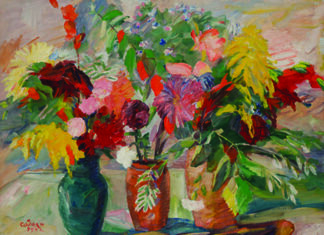SAN FRANCISCO — Armen Der Kiureghian, professor of engineering at the University of California, Berkeley, has published a book about the life and work of his father, Sumbat Der Kiureghian, a renowned Iranian-Armenian watercolorist known simply by his first name.
The Life and Art of Sumbat includes 120 pages of color reproductions of Sumbat’s paintings, drawings and sketches, as well as Sumbat’s biography, written by his son and full of personal anecdotes and letters.
Der Kiureghian compiled the material over a period of nine years, drawing on archival resources in Iran, Armenia and the United States, as well as interviews with Sumbat’s friends and relatives across the globe. He describes his father’s life through a series of intimate stories and quotations from other writers. The foreword is written by Armenian cultural anthropologist Levon Abrahamian. Haroutiun Samuelian, also of Armenia, designed the graphics and layout of the book. The book was published by ADK & Associates Publishers in San Francisco and printed by Printinfo JS LLC in Yerevan, Armenia.
Sumbat (1913-1999) was a highly-regarded Iranian-Armenian artist, who is particularly admired for his watercolor and gouache renditions of Iranian and Armenian village scenes and of landscapes. A descendant of 17th-century Armenian settlers in the New Julfa district of Isfahan, he embodied the artistic traditions of his people and his hometown. Through his art, he played the role of a mediator between East and West: he brought a European artistic style (lucid watercolor applied in loose brushwork) to Iran and he introduced Iranian lifestyle, folk traditions and landscapes to Western audiences.
Aside from their artistic value, the significance of Sumbat’s paintings lies in their preservation of a way of life that has since been lost to modernization. Of particular note are his “Sumbastisms,” created by turning his newspaper-palettes into abstract depictions of busy street scenes. These works capture the energy and diversity of Iranian society while also straddling the line between figurative and abstract painting. The common threads that unite all of Sumbat’s works are his stunning, gentle colors, an inescapable sense of joy and tranquility in his subjects and a strong appreciation for the life of ordinary people.









